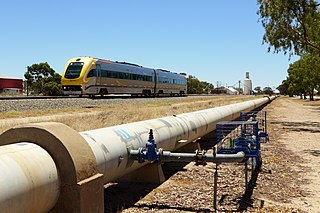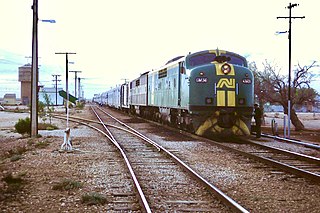Related Research Articles

Mundaring is a suburb located 34 km east of Perth, Western Australia on the Great Eastern Highway. The suburb is located within the Shire of Mundaring.
The Midland line is a suburban rail service on the Transperth network in Perth, Western Australia. It runs on the Eastern Railway through Perth's eastern suburbs and connects Midland with Perth. Travelling from Midland, the trains terminate at Fremantle on the Fremantle line.

The Eastern Railway is the main railway route between Fremantle and Northam in Western Australia. It opened in stages between 1881 and 1893. The line continues east to Kalgoorlie as the Eastern Goldfields Railway.

The Spirit of the West was a restaurant train operated by South Spur Rail Services out of Perth, Western Australia from 2002 until 2008.

Western Australian Government Railways (WAGR) was the operator of railway services in the state of Western Australia between October 1890 and June 2003. Owned by the state government, it was renamed a number of times to reflect extra responsibility for tram and ferry operations that it assumed and later relinquished. Westrail was the trading name of WAGR from September 1975 until December 2000, when the WAGR's freight division and the Westrail name and logo were privatised. Its freight operations were privatised in December 2000 with the remaining passenger operations transferred to the Public Transport Authority in July 2003.

The Eastern Goldfields Railway was built in the 1890s by the Western Australian Government Railways to connect Perth with the Eastern Goldfields at Coolgardie and Kalgoorlie.

The Mundaring Weir Branch Railway was constructed from Mundaring, Western Australia to the site of the Mundaring Weir, and opened on 1 June 1898.


The Westland was the name given in 1938 to the overnight train operated by the Western Australian Government Railways (WAGR) with sitting and sleeping cars between Perth and Kalgoorlie, where it connected with the Trans-Australian service to Adelaide.

Railways in Western Australia were developed in the 19th century both by the Government of Western Australia and a number of private companies. Today passenger rail services are controlled by the Public Transport Authority through Transperth, which operates public transport in Perth, and Transwa, which operates country passenger services. Great Southern Rail operates the Indian Pacific.

Kalgoorlie railway station is the easternmost attended station in Western Australia, located at the eastern terminus of the Eastern Goldfields Railway. It serves the city of Kalgoorlie. Beyond Kalgoorlie, the line continues east as the Trans-Australian Railway.

Rail Heritage WA is the local trading name of the Australian Railway Historical Society Inc.

The WAGR X class is a now-withdrawn class of diesel locomotives built by Beyer, Peacock & Company and Metropolitan-Vickers, Bowesfield Works, Stockton-on-Tees for the Western Australian Government Railways (WAGR) between 1954 and 1956. Several members of the class have been preserved.

The network of railway lines in Western Australia associated with the timber and firewood industries is as old as the mainline railway system of the former Western Australian Government Railways system.

The WAGR W class is a class of 4-8-2 steam locomotives operated by the Western Australian Government Railways (WAGR) between 1951 and 1972.

The WAGR P and Pr classes were two classes of 4-6-2 steam locomotives designed for express passenger service on the Western Australian Government Railways mainline network. The initial designs were prepared by E.S. Race and together the two classes had a total build number of thirty-five locomotives, the P and Pr classes entering service in 1924 and 1938 respectively. Both classes were used on express passenger services, greatly improving the economy and speed of long-distance passenger travel in Western Australia, the results of which were most visible on the Western Australian stage of the Trans-Australian Railway and Westland Express.
East Perth Locomotive Depot was a major steam locomotive depot for the Western Australian Government Railways from a year before the end of the First World War in 1917 until the end of the steam railway era on its railway system in 1970/1971. The previous locomotive depot had been located west of the Perth railway station.

The Trans-Australian was an Australian passenger train operated by the Commonwealth Railways initially between Port Augusta and Kalgoorlie on the Trans-Australian Railway line, and later extended west to Perth, and east to Port Pirie and Adelaide.

The Kalgoorlie was a railway passenger service operated by the Western Australian Government Railways between November 1962 and November 1971.

The Beverley Times is a defunct English language newspaper that was published weekly in the Wheatbelt town of Beverley, Western Australia, between 1905 and 1977.
References
- ↑ "The Westland / Australian Railway Historical Society W.A. Division (Inc.)". National Library of Australia. Retrieved 23 June 2020.
- ↑ Australian Railway Historical Society. Western Australian Division (1972), The Westland express, Australian Railway historical Society, W.A. Division, retrieved 12 May 2016
- ↑ Australian Railway Historical Society. Western Australian Division (1900), Westlander, Australian Railway Historical Society, W.A. Division, retrieved 24 June 2020
- ↑ "The Westland / Australian Railway Historical Society W.A. Division (Inc.)". National Library of Australia. Retrieved 28 December 2015.
- ↑ Sales Railway Heritage WA
- ↑ "Westland back on the rails". Rail Page. 8 February 2008. Retrieved 28 December 2015.
- ↑ Annual report for the year ended 30 June 2012 Rail Heritage WA
- ↑ Pusenjak, Nicholas (2008), The westland : the journal of rail heritage W.A. : Issue 258, 2007/8, Rail Heritage W.A, retrieved 12 May 2016
- ↑ https://catalogue.slwa.wa.gov.au/record=b1145747~S2 SLWA identified the 2018/2019 last edition received